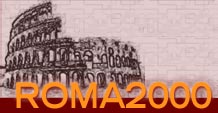
This itinerary starts from Piazza del Popolo and crosses the old
city with its monuments; the ancient Campo Mar-zio brings us to
the heart of Rome with the Pantheon and the most famous squares: Piazza Navona, Piazza Farnese and Campo de' Fiori.
We can reach this square from the Flaminio station on Line A of
the underground. Going through the old gateway of Porta del
Popolo we can see one of the finest architectural designs of the
neoclassical period.The square, by G. Valadier, opens onto the
so-called Trident, with the intersection of three streets (Via del
Corso, Via di Ripetta and Via del Babuino) between the twin
churches of S. Maria di Montesano and S. Maria dei Miracoli.
On the square, which has an obelisk at the centre there is also
the church of S. Maria del Popolo to the left of the gateway.
Among its many masterpieces, it houses two works by Caravaggio.
Going down Via di Ripetta, we can see the Ara Pacis on the right: this is an altar surrounded by square marble panels with sculptures in relief, consecrated in 9 B.C. to celebrate the peace established by Augustus in the Mediterranean.
Continue down Via di Ripetta, we reach Piazza Augusto Imperatore, with the Ara Pacis and the Mausoleum of Augustus. Little remains of the ancient circular mausoleum which Augustus has built for himself and his family in 28 A.D.
Going along Via Tomacelli we turn right on Via del Corso, and
shortly after Piazza S.Lorenzo in Lucina opens up to the right. In it is the church of the same name, one of the most ancient Christian basilicas in existence. The interior of the church, which dates to the 17th century, contains a number of chapels including the one finely decorated by Fonseca. The high-altarpiece is a Crucifixion by Guido Reni. As we proceed along Via Campo Marzio, we turn right on Via Uffici del Vicario and reach Piazza Montecitorio.
Piazza Montecitorio was designed by Bernini and completed by C. Fontana in 1607. Since 1871 it has housed the Chamber of Deputies. The obelisk, set up in the square in 1787, was the gnomon of an huge sundial at time of Augustus.
Going through Via in Aquiro and Piazza Capranica we reach Piazza della Rotonda,
decorated by a fountain, with the Pantheon.
Facing away from the Pantheon we go down Via Giustiniani to Piazza S. Luigi dei Francesi. The French church, which gives its name to the square, was completed in 1589 with the contributions of Della Porta and Fontana. Inside, the fifth chapel houses three works by Caravaggio dedicated to St. Matthew.
Proceeding along Via del Salvatore we reach Piazza Madama with the 16th centur. Palazzo Madama, which has housed the Italian Senate since 1871.
Crossing Corso Rinascimento, where at N. 40, in the courtyard of the Palazzo della Sapienza,
seat of the University of Rome from the 14th century until 1935, we find
the church of S. Ivo by Borromini, before coming Piazza Navona.
Continuing beyond Palazzo Pamphili, seat of the Brasilian embassy, and going down Via di Pasquino, we reach Piazza di Pasquino with its mutilated, worn statue named after a cobbler who was said to have composed anonymous posters with caustic comments against the Pope and the nobility, affixed to the statue as early as the 16th century.
Going down Via del Governo Vecchio, known as the Via Papalis since it was used by the Popes to reach St. John Lateran up to the 15th century, there are numerous antique and second hand shops.
The church is called Nuova (new) because it was built upon request of St. Philip Neri in 1575 on the site of a medieval church.
The saint was buried here, and Pietro da Cortona took another twenty years to complete the frescoes. The adjacent Oratorio dei
Filippini was designed by Borromini as a music room.
Via Giulia
This is a Renaissance street named after Pope Julius II who appointed Bramante to build it in the early 16th century.
The street, lined by aristocratic
palaces, contains high quality antique and art shops.
The little church of S. Eligio degli Orefici, located in the street of the same
name to the right, was designed
by Raphael. Before reaching the Ponte Sisto we find the Fontana del Mascherone and an arch covered with vines.
The arch is all that remains of Michelangelo's project to connect Palazzo Farnese, of which we part of the gardens, with the Villa Farnesina across the river in Trastevere.
Piazza Farnese
The square is dominated by Palazzo Farnese. On either side there are the fountains by G. Rainaldi, consisting of large basins with the lily, the emblem of the Farnese family.
The palace, built for Paul II Farnese, was begun in 1514 by A. Sangallo the Younger, continued by Michelangelo and completed by Giacomo della Porta in 1589. Michelangelo made the cornice, the 1st floor loggia and the courtyard. The palace houses the French embassy and is not open to the public.
The square takes its name from the flowers meadows which were until the 15th century, when it became a marketplace. Executions used to place here, and one of the victims commemorated with a bronze statue was the philosopher Giordano Bruno, burnt alive for heresy in 1600. A market is still held in the square.
Crossing the square, we reach Corso Vittorio Emanuele II and Largo Argentina in a few minutes. During building improvement work in 1926 the remains of four temples of the Republican age were discovered, the oldest one dating to the 4th century B.C. This is called the sacred area. |

